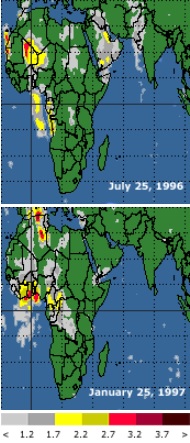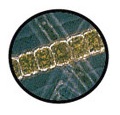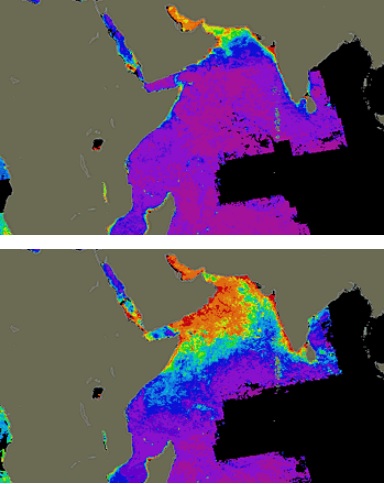Between 1994 and 1996 the Joint Global Ocean Flux Experiment (JGOFE) was conducted in the Arabian Sea to study ocean biological and physical processes and their links to the global carbon cycle. Supported by the Office of Naval Research (ONR) and National Science Foundation (NSF) and involving several research ships, the researchers set out to define the seasonal cycle of the Arabian Sea and determine how it relates to oceans around the world.
"The Arabian Sea is unique from many other ocean basins," said Robert Arnone, Head of the Ocean Color Section of the Naval Research Laboratory at Stennis Space Center. "Monsoons sweeping through the Arabian Sea affect light levels, yielding significant biological growth in its surface waters."
Phytoplankton growth and other biological activity increase in direct proportion to the amount of incoming sunlight (shortwave) and available nutrients, including dissolved nitrate and phosphate. Nutrient fields reflect horizontal and vertical ocean circulation processes (called advection and upwelling). Light levels are, of course, a function of weather conditions. The experiment measured the dynamics between these parameters in the Arabian Sea.
By the time the campaign closed, Arnone realized that the light field affecting phytoplankton growth was far from uniform, and that it would be necessary to quantify variations within the light field to understand phytoplankton growth and activity. So, Arnone and his collaborators set out to model light levels in the Arabian Sea and if possible, correlate light levels with phytoplankton growth.
The research team discovered that during June and July, monsoons increase cloud cover and aerosols, lowering the amount of light available at the ocean surface for photosynthesis. The amount of light actually reaching the sea surface is thus sometimes at a minimum in summer, which is different from other northern latitude ocean basins. Usually, in the North Atlantic for example, phytoplankton bloom in April, but in the Arabian Sea they bloom in August.
In modeling Arabian Sea light dynamics, Arnone used Coastal Zone Color Scanner (CZCS) data from NASA's Goddard Earth Sciences Data and Information Service Center (GES DISC) to map the average distribution of aerosol around the globe and Total Ozone Mapping Spectrometer (TOMS) data from the DAAC to map average global ozone levels. Arnone also used data from the Air Force to create maps of average global cloud cover. With these data he created a model that is capable of determining the variability of the light levels reaching the sea surface for the each location in the Arabian Sea, and the show how light levels change each month for a period of several years. The team was able to characterize the annual cycle of incoming light levels driving phytoplankton growth.
"We were using actual satellite-derived values," Arnone said. "Real data, not modeled output, that came from CZCS and TOMS were combined with a model to produce maps of photosynthetically available radiation, or solar irradiance fields." Photosynthetically available radiation (PAR) refers to those wavelengths — roughly 400-700 nanometers — of incoming sunlight that can be absorbed by plants for photosynthesis.
With the light fields, Arnone and his team discovered that, indeed a different PAR cycle was operational in the Arabian Sea than in other oceans of the world. They also confirmed that PAR cycles within the basin are far from consistent. For instance, because cloud cover and aerosols are different from one area to another within the basin, the southern regions of the Arabian Sea have a different annual cycle of light intensity than those of the northern regions.
"We detected 'patches' of sunlight intensity reaching the ocean surface within the photosynthetically available radiation cycle in the Arabian Sea," said Arnone. "We also observed corresponding patches of phytoplankton growth at the surface in satellite images. We are anticipating that the patches we saw within the light levels are linked to the patches we observed in the phytoplankton. But, I don't think we've proven that completely. The response time for phytoplankton growth to correlate with patches of increased light levels is shorter than we expected."
Nonetheless, Arnone and his team have developed a new way of measuring incoming light intensity on the ocean surface and identified that accurate light levels are important for projecting phytoplankton growth.
"This is probably one of the first times we've been able to demonstrate that a changing light field reaches the ocean surface. We observed major light changes across the ocean basin and throughout the yearly cycle, and observed a correspondence with phytoplankton growth," said Arnone. "Traditionally, biological models use just one number to represent incoming light for the entire Arabian Sea," he said. "This study demonstrates the amount of incoming light varies spatially and temporally within an ocean basin, and accounts for biological activity observed in the basin."
The techniques used to estimate light levels in the Arabian Sea can be extended to other ocean studies, he said.
"We used these techniques several years ago in the North Atlantic and refined them in the Arabian Sea," Arnone said. "Now, we may extend the models to the Gulf of Mexico and into the New England coast. The future also holds that we will go back to the Arabian Sea and continue to improve the knowledge of the biological cycles and variability of the surface light field that are occurring there."
References
Arnone, R.A., S. Ladner, P.E. La Violette, J.C. Brock, and P.A. Rochford, 1998: Seasonal and interannual variability of surface photosynthetically available radiation in the Arabian Sea, J. Geophys. Res., 103, pp. 7735 - 7748.
For more information
NASA Goddard Earth Sciences Data and Information Services Center (GES DISC)
Coastal Zone Color Scanner (CZCS)
Total Ozone Mapping Spectrometer (TOMS)
| About the remote sensing data used | ||
|---|---|---|
| Sensor | Coastal Zone Color Scanner (CZCS) Total Ozone Mapping Spectrometer (TOMS) |
|
| Parameter | oceanic seasonal cycles and phytoplankton | |
| DAAC | NASA Goddard Earth Sciences Data and Information Services Center (GES DISC) | |



